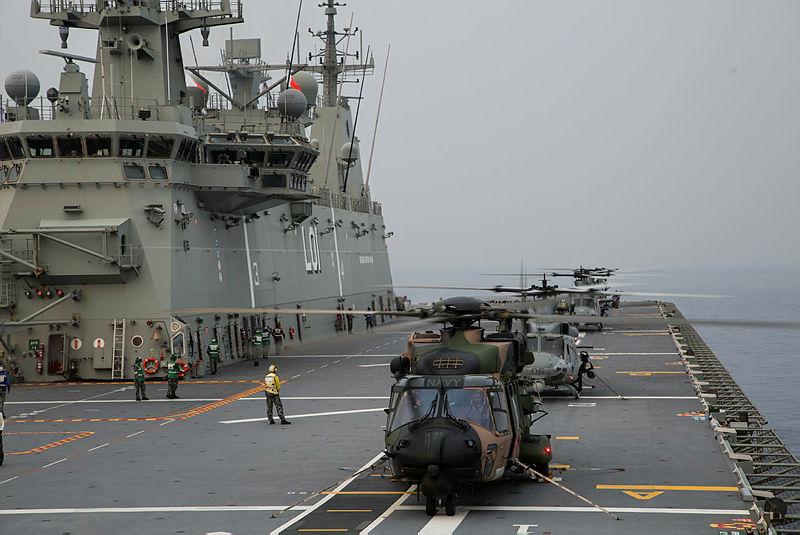
Sea state
The multinational Rim of the Pacific Exercise concluded this week with an amphibious landing trial. The US was supposed to participate, but was sidelined when two of its biggest warships, USS Bonhomme Richard (LHD-6) and USS Boxer (LHD-4), suffered mechanical failures. In the end, Australia’s HMAS Adelaide practised the amphibious assault almost by itself, assisted by the Filipino navy’s new landing platform dock BRP Davao del Sur. Analysts say that the failure of the warships indicates an ‘amphibious readiness gap’ in the US Navy.
Iran’s Islamic Revolutionary Guards Corps conducted a massive military exercise involving 100 warships in the Strait of Hormuz, a strategic waterway that’s crucial for regional connectivity and trade. The drills were purportedly held to send a message to the US amid heightened tensions following President Donald Trump’s decision to withdraw from the Joint Comprehensive Plan of Action. The Iranian ships are ‘small, fast, deadly, and designed specifically to present an asymmetrical threat to the toughest ships’ and could ‘cripple’ the US Navy through guerrilla tactics.
The recent Iranian war games are reminiscent of the infamous Millennium Challenge 2002 run by the erstwhile US Joint Forces Command. The red team, which was playing the enemy forces, used unexpected tactics and destroyed the blue team’s navy. Unhappy with the result, the blue team resurrected its forces and manipulated the outcome by cheating. The exercise is a case study on how a small, well-organised navy can defeat a much bigger and stronger adversary.
Flight path
A group of airmen and -women are trying to build a healthier US Air Force by establishing a support network. Wingmen Connect is designed to foster a culture of support through mentoring. The mentors are all trained and vetted senior personnel who volunteer to share their experiences and provide information. The program aims to create a more resilient air force, though it needs more mentors and isn’t a substitute for professional counsellors and services.
The Royal Air Force worked with local authorities to bring a wildfire under control in Cyprus. Eighty-four Squadron, based at Akrotiri, deployed a Griffin helicopter to help battle the blaze, which was endangering homes. Squadron personnel are on standby year-round to help fight fires in the area. Sustained hot and dry conditions in Europe have caused fires to spread rapidly in many countries, including Greece and Sweden.
India has conducted the first successful multiple-target test of its Advanced Air Defense (AAD) interceptor missiles. An incoming medium-range ballistic missile was successfully detected and destroyed despite the use of multiple decoys. The AAD intercepts targets at an altitude of 15 to 25 kilometres and is part of India’s two-tier ballistic missile defence system.
Rapid fire
The US Army is dealing with internal tensions over funding, resources and a program that can combine signals intelligence and electronic warfare. Breaking Defense reports that there are concerns the electronic warfare element of the Terrestrial Layer Intelligence System will be dropped to save costs. If that happens, the system would become a passive sensor rather than a jamming weapon and risk ceding further ground to Russia and China in the electronic warfare arena.
The US Army has opened a new drone school to train and prepare soldiers to target enemy drones. The small unmanned aerial system course provides basic training to infantry soldiers and cavalry scouts as part of a plan to educate trainee soldiers on how drones fly and ‘how to describe them if they see one flying over their formation’. Soldiers are also taught how to hide from enemy drones and avoid artillery casualties caused by drone-directed strikes.
Zero gravity
In the business of launching satellites, reusable rocket technology offers efficiency at a considerably lower cost. The US is leading in the development of reusable rockets—for example, SpaceX is getting ready for the second launch of an already flown Falcon 9 Block V rocket, and Blue Origin is aiming for a 2020 launch date for its large New Glenn reusable booster. But others are working hard to catch up. The Japanese Aerospace Exploration Agency is planning to launch a ‘reusable rocket’ in 2019 in a bid to enhance the country’s international competitiveness in the race for space. China’s Academy of Launch Vehicle Technology is developing its LD-1 reusable rocket and Long March 8 rocket.
US Air Force General Carlton Everhart II wants to use space technology to support logistics in military space operations. He recently met with executives from SpaceX and Virgin Orbital to talk about how they could help the air force position military cargo in space for quick access in adverse situations. While the project is in its infancy, Everhart views it as integral to sustaining the efficacy of the US Air Force.
NASA’s planetary protection officer works on preventing human contamination of extraterrestrial environments and keeping potential extraterrestrial biohazards from threatening the earth’s biosphere. Space researchers have identified critical knowledge gaps in the study of interplanetary biological contamination, including the effects of microbes on human health and extraterrestrial surfaces and of contaminant transfer from earth to destinations such as Mars.
Wired watchtower
In a joint operation with the FBI, Australian agencies played a critical role in the arrest of three Eastern European cyber criminals. The Ukrainian nationals are alleged high-ranking members of the sophisticated FIN7 cybercrime outfit, also known as the Carbanak Group. This is but one example of the global effort to crack down on transnational cybercrime.
The European Parliament elections set for May 2019 could be a major target for cyberattacks. According to a report by the State Information System Authority, the warning comes from consideration of specific cyber incidents occurring during member states’ elections. While no attacks have yet affected results, the May elections will be the first EU-wide political event to take place in the current threat-heavy environment.